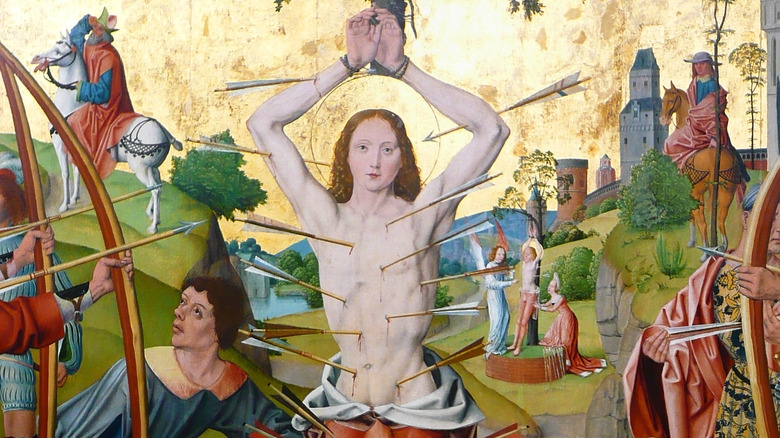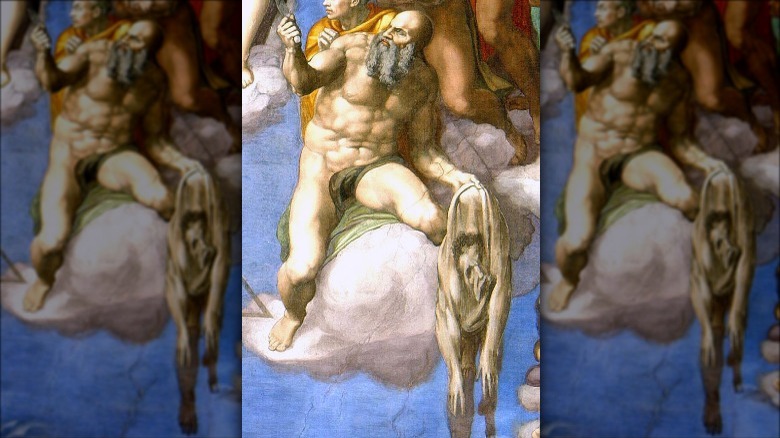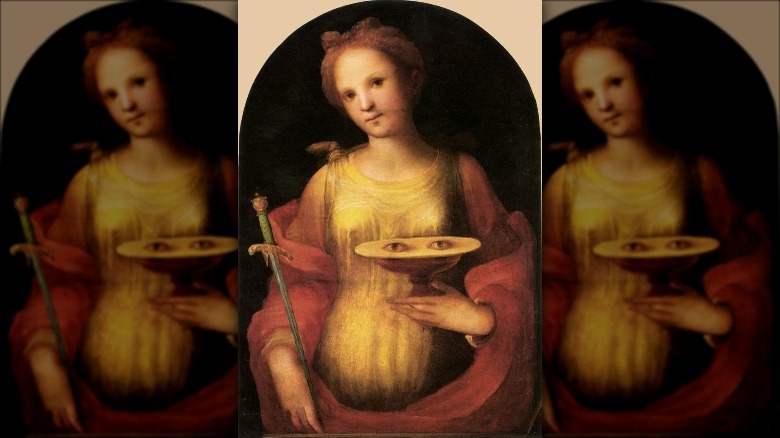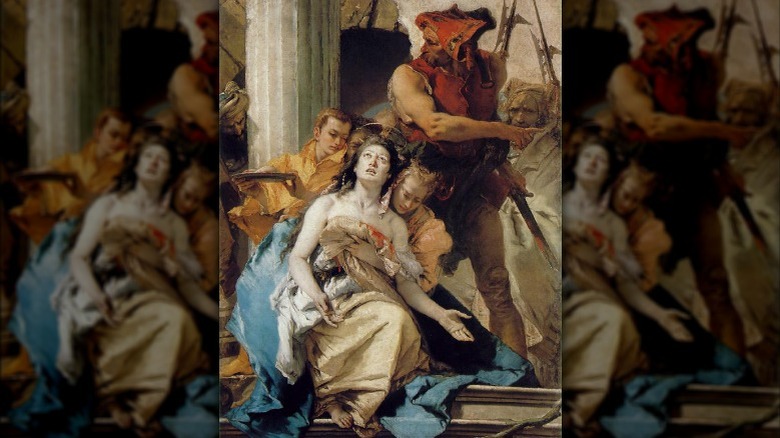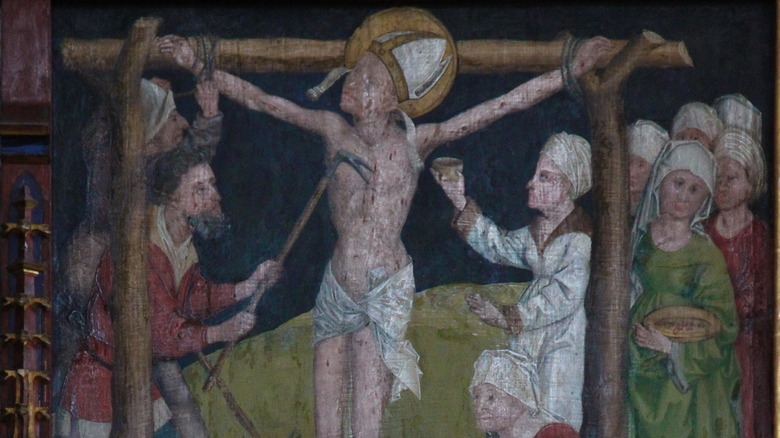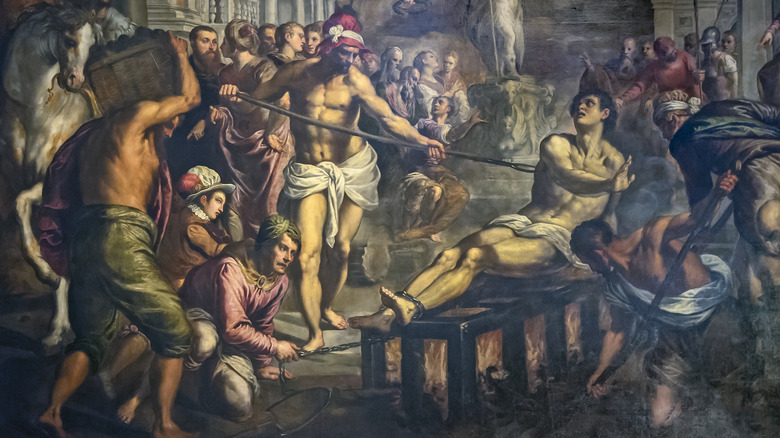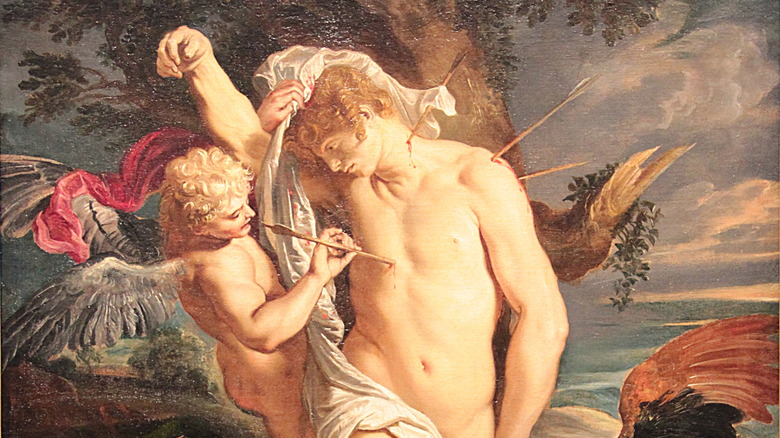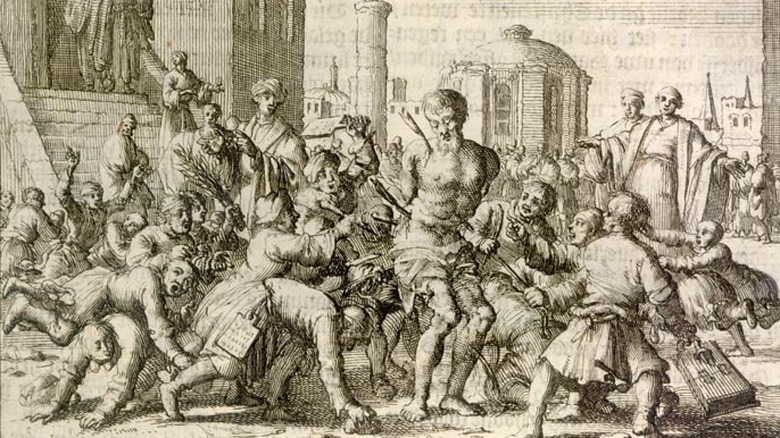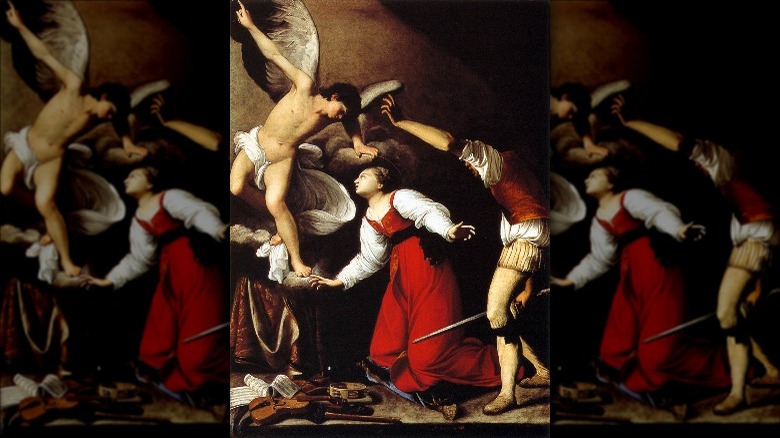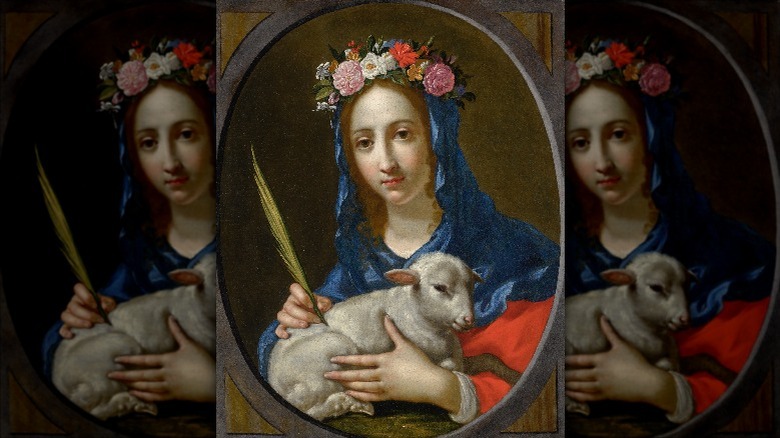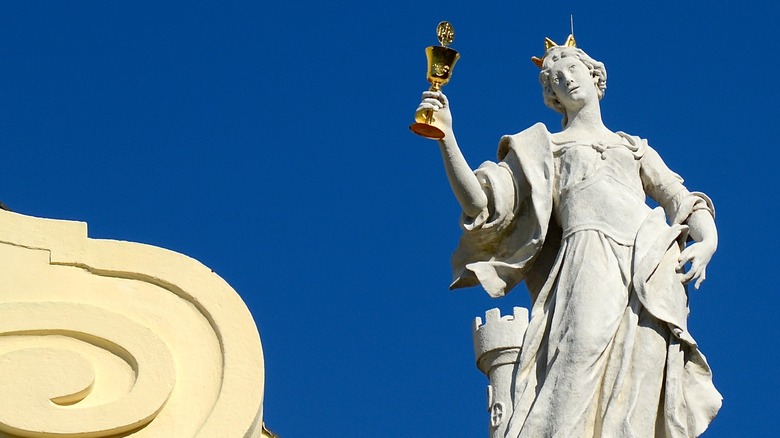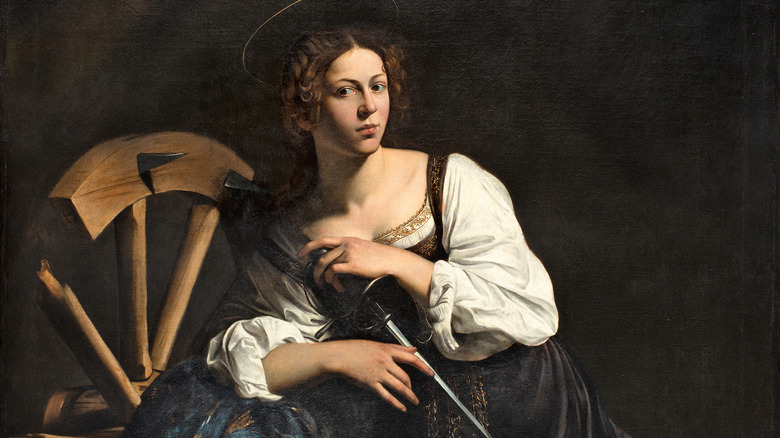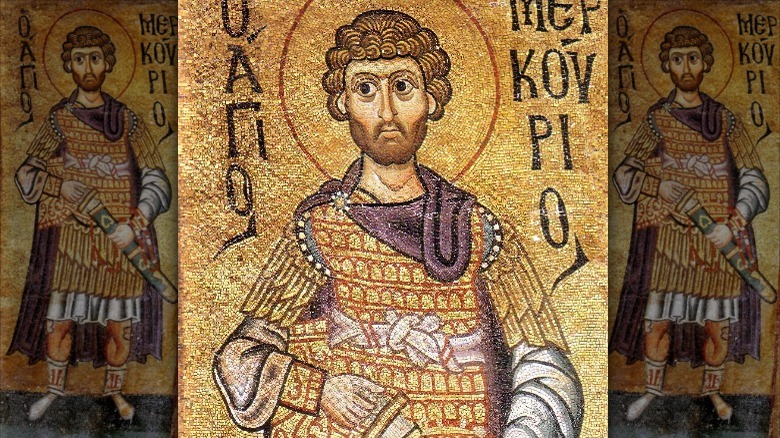The Most Gruesome Deaths Of Saints
Within some Christian denominations, saints are holy people who can serve as intercessors in Heaven for believers on Earth. As the Encyclopedia Britannica explains, many of the earliest saints were martyrs -– that is, people killed for their faith -– because it was (and is) believed that martyrdom basically gives someone a direct ticket to Heaven. Most of these early martyrs were men and women who lived during the anti-Christian persecutions of Roman emperors such as Decius, Diocletian, and Julian the Apostate, who reigned in the first handful of centuries CE.
Stories of the lives of saints were a very popular literary genre in the Middle Ages, with many of them taking on elements of adventure, romance, and even Grand Guignol-style violence. Since stories of macabre and gory violence could be enjoyed with the permission of the Church when they also imparted important religious messages, some saint stories could get downright bloodthirsty. Here are some examples of the most hideously violent saintly deaths.
Bartholomew: skinned alive
According to the website Christianity, Christian tradition says that all of Jesus's 12 apostles -– including Matthias, the guy who replaced Judas, and Paul, who was only kind of grandfathered in as an Apostle –- were martyred except John, who died of old age. For the most part, these were pretty standard executions of the day: stoning, beheading, and crucifixion (although the crucified Apostles, such as Peter, Andrew, and Philip, are traditionally said to have been nailed to crosses of non-standard shapes–upside-down, X-shaped, and sideways, respectively, in order not to seem like they were copying Jesus). But there's one Apostle who had a particularly gruesome death that has led to some surprisingly Clive Barker-esque religious art.
As the Catholic Encyclopedia explains, tradition says that the Apostles cast lots to determine who would go where in the world to spread the message of Jesus. The Apostle Bartholomew (possibly called Nathaniel in the Gospel of John) is said to have been sent to India, though in the most popular account, he ultimately ends up in Armenia, where he is arrested and sentenced to death for converting the king. As part of his execution, Bart was flayed alive; that is, all his skin was cut off. As a result, in many artistic depictions, including very notably in the Sistine Chapel, a sometimes skin-having, sometimes skinless Apostle is shown holding his own empty dermis or even wearing it like a cape.
Lucy: eyes gouged out
As the Encyclopedia Britannica explains, Saint Lucy is a very popular saint, especially in Scandinavia, where her feast day on December 13 marks the beginning of the Christmas season, celebrated by young girls dressed up as the saint in white dresses and wearing crowns of candles. This adorable tradition somewhat belies the bloody end of the virgin saint of Syracuse, who lived and died in the late 3rd century, during the persecution of Christians by the emperor Diocletian.
According to the saint's legend, Lucy came from a rich family in Sicily who, naturally, wanted her to marry into another rich family. However, young Lucy had dedicated herself to Christ and decided to remain a virgin forever. When the man who was arranged to be her husband found out, he reported her to the Roman officials, who sentenced her to a life of forced sex work. When they came to drag her to the brothel, however, they found her supernaturally unable to be moved, even by dozens of men and oxen. They tried then to burn her alive, but she was untouched by the flames. Finally, she was killed by being stabbed through the throat. However, a later but incredibly popular addition to the legend said that her eyes were gouged out as part of her torture. As a result, Lucy is venerated as the patron of the blind and is often depicted in art holding her own eyes on a plate.
Agatha: breasts cut off
Saint Lucy was not the first virgin martyr from Sicily, however. As the Encyclopedia Britannica explains, she was preceded in martyrdom -– and indeed, directly inspired by -– Saint Agatha, who lived earlier in the 3rd century during the persecutions of the Roman emperor Decius. Like Lucy, Agatha had sworn herself to perpetual virginity, and so she rejected the advances of a Roman prefect who had been sent to Sicily by the emperor. Her rejection of this powerful man and profession of an illegal faith led to her being horribly tortured, with the most famous detail being that her breasts were cut off with giant pincers. During her extended imprisonment under torture, Agatha is said to have been visited by an apparition of Saint Peter, who healed her wounds. The frustrated Roman prefect then condemned her to be burnt at the stake, but a sudden supernatural earthquake doused the flames. Agatha subsequently died under further tortures in prison, which included being rolled over hot coals and shards of rock.
According to the Catholic Spirit, because of the powerful and memorable image of Agatha's breasts being cut off, she is venerated today as the patron of basically anything to do with breasts, including breast cancer patients and wetnurses, frequently depicted in art holding her severed breasts on a plate. In an amusing twist, some viewers of such depictions thought she was holding small bells, and as a result, Agatha is also the patron of bell-makers.
Blaise: raked with hot combs
The iconography of saints -– that is, the symbols that represent them in art and often help define their patronages -– usually comes from a notable and memorable moment in their life story, and in the case of martyrs, it's often an implement of their death, such as a sword for those who were beheaded. In the case of 4th century bishop Saint Blaise, however, he is perhaps most associated with a miracle he performed. As the Encyclopedia Britannica explains, while Blaise was imprisoned during the Roman persecutions of Christians, he miraculously saved a young boy who was choking to death on a fishbone. As a result, he is the patron of those suffering from throat disease, and on his feast day in February, some churches today still perform blessings of the throat in the name of Saint Blaise using two crossed candles touched to either side of the throat.
That's not to say, however, that Blaise's death doesn't come into play. After hiding out from Roman officials in the wilderness, Blaise was discovered, imprisoned, and tortured. The most shudder-inducing torture of all was that his skin was raked off with red-hot wool combers' irons. As a result, Blaise is also venerated as the patron of wool combers. After having all of his skin scraped off with hot combs, it was probably a mercy when the officials finally just cut off his head.
Lawrence: grilled alive
While to many North Americans, Saint Lawrence is possibly best known as the namesake for the river that flows through New York, Ontario, and Quebec, to those who know the lives of saints, Saint Lawrence is renowned for having possibly the funniest last words in the world of martyrs. As Catholic Culture explains, Lawrence was a young deacon and disciple of Pope Sixtus II, who lived in the middle of the 3rd century. During the persecution of Christians by Emperor Valerian, the pope and his followers were arrested and beheaded. After the death of the pope, the Roman prefects demanded that Lawrence hand over the treasures of the church to them. Instead, Lawrence gave away all the riches he could gather to the poor and sick. When the Romans demanded he hand over the church's assets, Lawrence presented them with the sick and needy, saying, "Here are the treasures of the church."
Perhaps needless to say, he was arrested and tortured. After being whipped and burned with scalding plates, Lawrence was most famously sentenced to be roasted alive on a giant gridiron. Rather than succumb to the torments, Lawrence iconically quipped to his torturers, "Turn me over, I'm done on this side." Just before his death, he turned to his captors and said, "I'm finished now, you can eat me." For his death, Lawrence is venerated as the patron of chefs, firefighters, and tanners, and, thanks to his one-liners, comedians.
Sebastian: arrowed then clubbed
In certain internet circles, it's become something of a meme to note the surprising sexiness of artistic depictions of the martyrdom of Saint Sebastian, as in this piece by Daniel Lavery from 2015. As the Encyclopedia Britannica explains, the death of Saint Sebastian, his body full of varying numbers of arrows, was indeed a favorite subject of Renaissance artists, perhaps because it provided a religious excuse to depict a mostly naked human form in the agony and ecstasy of being penetrated by cylindrical objects. Who can say? At any rate, despite the popularity of the image of Saint Sebastian looking like a pin cushion — in fact, a medieval account of his life says he was as full of arrows as a hedgehog is full of quills -– it might surprise you to learn that Sebastian did not actually die due to being shot full of holes.
According to legend, Sebastian was a Gaul who came to Rome during the reign of the anti-Christian emperor Diocletian and joined the Roman army. However, it was soon discovered that he had been converting his fellow soldiers to Christianity, which Diocletian did not care for one whit. Sebastian was sentenced to be killed with arrows, as depicted in the popular artistic motif. However, Sebastian miraculously survived and was healed by a Christian widow. When the revived Sebastian presented himself to the incredulous Diocletian, the emperor had him beaten to death with clubs and his body thrown in the sewer.
Cassian of Imola: ripped apart by tiny hands
Most of the saints covered here are relatively well known, with many of their memorable martyrdoms becoming common motifs in art and allusion. Saint Cassian of Imola, by comparison, is much more obscure, being, as Catholic Online notes, only commemorated on the local level. Nonetheless, as the Encyclopedia Britannica explains, Cassian lived in Imola, Italy, near the modern town of Ravenna, during the reign of the Roman emperor known as Julian the Apostate, so-called because he was the first emperor post-Constantine to turn away from Christianity. Cassian had been a bishop in Brescia, but upon being exiled from that city, he moved to Imola, where he retired to what he thought would be the quiet life of a schoolmaster.
However, when the whole town of Imola was ordered to make sacrifices to the pagan god by the emperor, Cassian refused, which got him in trouble with the local officials. They arrested him and sentenced him to death at the hands of his own students. Anyone who has ever worked as a teacher would probably recognize the vengeful malice in the eyes of Cassian's students as they bashed him with their writing tablets and ripped him to shreds with their iron styluses, penknives, and tiny child hands. Because the children were small and couldn't deal lethal blows with their child strength, it's said that Cassian's agony was prolonged and he died slowly.
Cecilia: (mostly) beheaded
As the patron saint of music, Saint Cecilia is popularly venerated by people who create sacred music. What is not as popularly depicted, however, is that she was the victim of a botched beheading. As Catholic Online explains, Cecilia was a young noblewoman of Rome who was betrothed to be married to a wealthy young man named Valerian. However, Cecilia was a Christian and prayed that God would help her preserve her virginity. During her wedding, she sang in her heart to God as the music played (hence her role as patron of music) and on her wedding night, she told Valerian that an angel guarded her chastity. Valerian asked to see the angel, and she told him that he would see him if he were baptized. After his baptism (by the pope!), Valerian indeed saw the angel and believed.
Soon Valerian's brother also converted, and the two dedicated themselves to giving Christian burials to those martyred by the local prefect. Valerian and his brother were arrested and martyred, and Cecilia was soon to follow. They tried to suffocate her by locking her in a heated bathhouse, but she survived. The emperor's executioner then tried to behead her, but after three whacks, her head was still hanging on by a thread, so she was left to bleed out over several days. During this time, she continued to preach to her followers as they gathered her holy blood in cloths.
Agnes: thrown in a brothel and stabbed in the throat
According to the Catholic Encyclopedia, none of the virgin martyrs of Rome were celebrated as much and as early as Saint Agnes, despite the fact that very little is agreed upon about her life in the early sources other than her death at a very young age, usually 12 or 13. As Catholic Online says, the common thread of legend is that Agnes was a beautiful girl whose hand was sought after by just about every young man in town. Nevertheless, as we've seen with so many other early female saints, Agnes had pledged her chastity to God and so rejected the advances of every suitor, including, fatally, the governor's son.
When she refused to let her spirit be broken by being bound in chains, the governor condemned her to life in a brothel. However, young Agnes and her virginity were protected by an angel of God, with her hair growing miraculously to cover her naked body and young men casting lascivious looks at her being struck blind. With this plan foiled, Agnes was sentenced to death. At first, the prefect tried to burn her at the stake, but the flames parted at the presence of the holy virgin's body. In the end, she died either by beheading or being stabbed in the throat. Today she is remembered as the patron of young girls and sexual assault survivors.
Barbara: beheaded by her dad
Even if you're familiar with the fact that there are saints that are venerated as the patrons of just about everything under the sun, it may still surprise you that there's a patron saint of explosions and really big guns. Nonetheless, Saint Barbara is it, even though as the Encyclopedia Britannica says her legend is pretty questionable. The story starts with a familiar tune: Barbara was the beautiful daughter of a pagan nobleman named Dioscorus, but pledged herself to Christ and virginity. At first, Dioscorus ordered a tower to be built to lock his daughter up in to protect her until she could be married, but, as the Catholic Encyclopedia explains, he then went out of town while it was being built and was enraged to find out that Barbara had had three windows installed in the tower as a symbol of the Trinity.
Dioscorus, having discovered that his daughter had become a Christian, went to drag her to the prefect to be executed, but she managed a number of miraculous escapes before he finally caught her. He imprisoned and starved her before bringing her to the prefect, who had her tortured before condemning her to be beheaded -– by her own father. Dioscorus carried out this horrendous act but was soon righteously punished: on his journey home, he was struck by lightning that blasted him to bits, thus ensuring Barbara's legacy as the patron of things that go boom.
Catherine of Alexandria: condemned to the wheel
Saint Catherine of Alexandria was a virgin martyr from the 4th century, who lived during the persecutions of the emperor Maximinus. Like many other virgin martyrs, she was born of a noble family and got in trouble for pledging her virginity to Jesus. However, as the Catholic Encyclopedia explains, a major difference between Catherine and other similar pious young women is that Catherine was extremely well-educated and skilled in the arts of rhetoric. She actually approached the emperor of her own volition in order to debate him on the merits of Christianity versus the state religion. The emperor summoned his finest scholars and philosophers to contend with her, but her powerful learning caused her not only to defeat them in debate but actually convert the scholars to Christianity as well.
After having these newly converted scholars put to death, Maximinus had Catherine arrested, whipped, and imprisoned. Catherine subsequently converted her jailers, for which she was condemned to die on a spiked wheel (which is known now as a Catherine wheel), but this instrument of torture broke to pieces when she touched it. With his torture wheel plan foiled, the enraged Maximinus ordered Catherine to be beheaded, after which angels carried her body to Mount Sinai. Catherine of Alexandria is venerated as the patron of unmarried women, scholars, students, and anyone who works with a wheel, like potters and spinners.
Mercurius: hung over fire and slashed with knives
Saint Mercurius was a Scythian who served in the Roman imperial army under the reigns of Decius and Valerian in the mid-3rd century. As the Orthodox Church in America explains, barbarian forces invaded the empire, and Decius led a large army to repel them. During one of the battles in this campaign, an angel appeared to Mercurius telling him that the Lord was going to lead him to a great victory. Following this supernatural visit, Mercurius cut huge swathes through the enemy forces and even killed their king, basically single-handedly winning victory for the Romans. Decius showered Mercurius in honors, but the angel reappeared to remind Mercurius of the debt he owed the Lord.
The holy warrior dedicated his life to the cause of Christ, which caused a problem when the emperor suggested the two should go together to make sacrifices to Artemis. When Decius discovered Mercurius was a Christian, the holy warrior threw down his armor and disowned all the honors he had received. The emperor had Mercurius tied to four pillars over a fire and his servants slashed at his body with knives. Mercurius bled so much that his blood put out the fire. Though near dead after this, the angel healed Mercurius, so the emperor did what many emperors so frustrated did before and after him: he had him beheaded.
